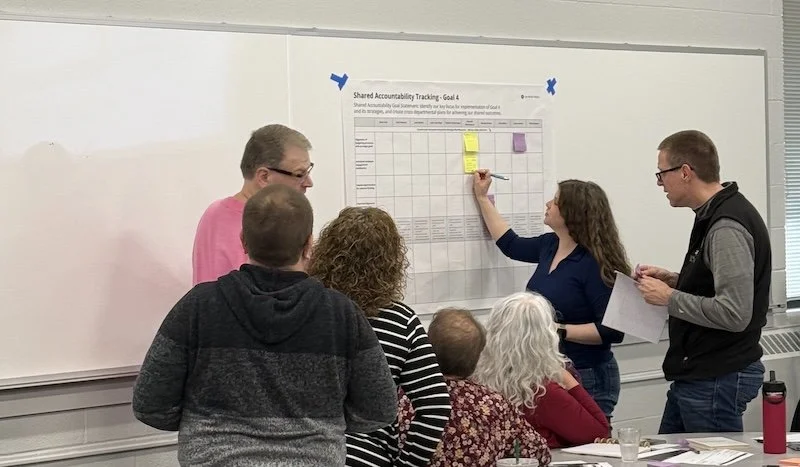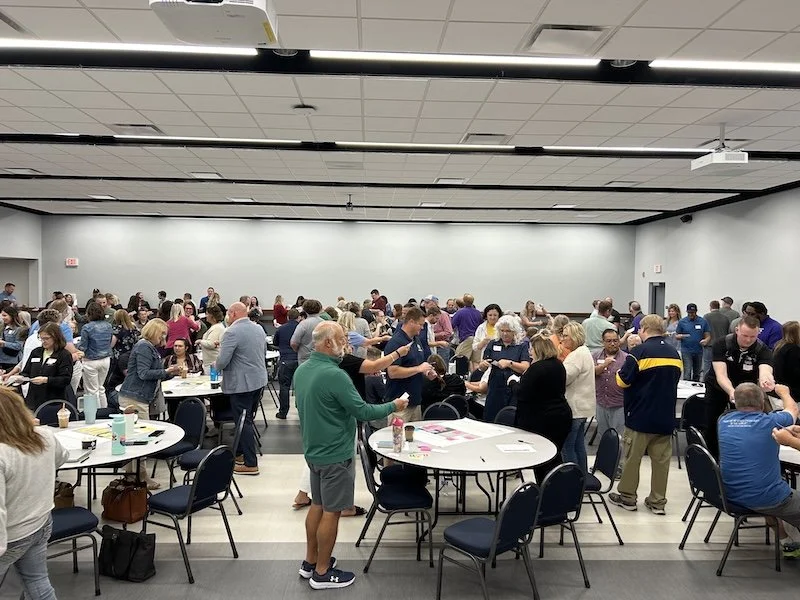Case Study: Building Trust Through Shared Accountability in Higher Ed
When Iowa Valley Community College District (IVCCD) began dreaming up a five-year strategic plan, the leaders quickly realized achieving the ambitious goals would take more than strong intentions and individual expertise. It would require a new way of working together.
In the past, some initiatives prioritized in a plan struggled to get off the ground.
“Usually we get the initiative and we're just told we have to do it,” Abigail Casey, Senior Director of Strategic Planning and Marketing, said. “But then it goes up on the shelf and we don't actually do it.”
This time around, they wanted their goals to stick, and Abigail knew they needed a new method.
IVCCD partnered with SWIM to introduce Shared Accountability, a method to advance work that spans multiple teams and give a much-needed update to team meetings.
SWIM developed the Shared Accountability model for organizations like IVCCD who are developing a common goal and need to engage leaders across the organization, each with unique expertise to contribute to success. IVCCD and SWIM got right to work.
Four Groups, Four Goals
The five-year strategic plan we worked on with IVCCD covers a wide range of priorities: quality learning experiences, student success, and fostering a diverse and inclusive community. Each area involves multiple departments, which can make coordination complex.
To organize their efforts, IVCCD followed SWIM’s recommendation to have four Shared Accountability groups — one for each strategic goal:
Goal 1: Inspire Lifelong Learning and Foster a Supportive Environment.
Goal 2: Empower Students for Success.
Goal 3: Prepare a Future-Ready Workforce.
Goal 4: Ensure Sustainable Growth Through Collaboration and Innovation.
In each group, there’s one executive leadership team member along with representatives from a variety of departments. For example, one team is made up of someone from HR, student success, adult education, faculty, and the Vice President of Business and Community Solutions — a group who likely wouldn’t work together if not for this initiative.
Abigail said that she felt excitement right away at the prospect of implementing Shared Accountability. Her anticipation was confirmed as they kicked things off, and she saw quick results.
What Shared Accountability Meetings Look Like at IVCCD
Abigail is the facilitator of all four Shared Accountability groups. She doesn’t carry out the work herself, rather, her role is to set the table where each person can contribute to the shared goal, influence the work of others, and ask for help.
Each meeting consists of a repeating structure that includes:
Individual accountability
Shared work
Committing again
Accountability Leading to Action
The meeting starts with holding oneself accountable to individual goals. Each person shares what they accomplished since the last meeting and asks for help getting un-stuck if needed. Abigail and the team use SWIM’s shared tracking sheet to see the status of everyone’s progress.
“Abigail doesn’t need to do all the work — she helps people know what they’re supposed to be doing when they get back to their departments.” —Jordan Vernoy, SWIM Consultant
SWIM’s Shared Accountability tracking sheet keeps people’s commitments, progress, and requests for help transparent. Examples above are for illustrative purposes.
“Accountability can be difficult,” Abigail said. “Especially in an environment where we have so many different things that we’re working on and so many daily demands.”
But she finds that group members are motivated by the transparency asked of them.
“They know if they don't do their work, everybody's going to know that they don't do their work — but at the same time they know they can get support for whatever their barrier is,” she said.
This has led to group members following through on what they committed to, which is exactly what the Shared Accountability model is designed to support.
Shared Work, Significant Results
Next, the group focuses on something they need to do together, or a topic everyone needs to understand. They either:
Focus on a task that needs all-hands to complete. Typically someone brings a rough draft to the table, or
One group member dives deep and shares what they’re working on and what they need help with.
The groups have been forthcoming in showcasing their work with one another. “I don't see any hesitancy in them holding back with this group,” Abigail said.
The shared work step of the meeting has been a time where problems have been solved quicker and more effectively than before.
One of IVCCD’s strategic plan measures is Prepare a Future-Ready Workforce. The related sub-goals include “increased number of job placements” and “increased opportunities for work-based learning (internships, apprenticeships).”
When there was a large-scale phishing attack on student accounts, one group got to work on cybersecurity training right away, helping to create videos that students would find engaging.
“I like that we were responding to an immediate need on campus,” Abigail said. She noted that having a cross-departmental group already meeting regularly provided the perfect setting for finding a quick solution.
Another group came up with a solution for creating a business partnership list to use for internship connections and workforce training. They’re gathering information to eventually put into a CRM so everyone has access to information about who on the campuses is contacting which businesses.
Instead of siloed knowledge, the district will now have a shared resource of business partners and communication touchpoints.
Other groups are working on:
New night classes: After years of requests from students, one of the groups is helping the nursing program come up with a plan to add night classes. Even though no one in the group is in the nursing department, they are still finding a way to support this important work for the district.
Distance learning improvements: A group sent out a student survey to evaluate the effectiveness of the distance learning program. They’re assessing education modalities and coming up with a plan for the future.
Block scheduling: A team is looking at the viability of moving to four- and eight-week classes to improve delivery of instruction.
Dual enrollment marketing: A group is looking to increase the services IVCCD provides for dual enrollment students. They’re developing flyers and displays for local high schools.
Mobilization Beyond the Meeting
To close out the meeting, each individual commits to what they want to get done by the next meeting. They record 1-3 action steps they will take on the shared tracking sheet.
Rather than taking several meetings to get everything done as a unit, Shared Accountability helps IVCCD mobilize their staff to work throughout the month on their goals in their own department.
Rather than deciding everything together, Shared Accountability leverages individual expertise and influence to help group members get independent work done in their own sphere.
Since Abigail is a facilitator for all four teams, she often eliminates redundant goal-setting. She said occasionally a group will want to put a goal on their list but another group is already tackling it. In siloed departmental meetings, no one would catch something like that. She invites people to visit other groups’ meetings if needed to share their expertise, further enhancing the collaboration across departments.
“Having a strong facilitator like Abigail is extremely important in these meetings. Shared accountability just does not work in the same way without one.” —Jordan Vernoy
She also helps people commit to their next steps if they can’t decide, pointing out something they shared during the meeting or helping them see how their role ties in with IVCCD’s strategic goals.
Building Relationships That Will Last
A resonant sticky note from an IVCCD planning session — to answer the question, “How do we work together to ensure we can successfully implement these strategies?”, one senior leader wrote: “Build Trust.”
IVCCD’s Shared Accountability groups have made enormous strides toward their goals that will help students access higher education, get internships, access night classes, and stay safe online.
But the primary goal of this first year of Shared Accountability? Build strong relationships that lead to trust.
Abigail said that in this early stage, “I just want to continue to build these teams and relationships, and their focus on what they can achieve together.”
Thanks to the makeup of the groups, faculty who work at different campuses and who may not otherwise work together are now on the same team. Different departments are working together toward shared goals. They say hi around campus thanks to their shared bond in this work.
The group members are supportive of each other in meetings, cheering each other on as they reach their goals.
“As people are reporting on the work they've done, there's just a lot of support and appreciation for the work that they're doing,” Abigail said.
Abigail had much to say about the positive relational outcomes of Shared Accountability, just six months in: Group members are sharing honestly with one another. Everyone can see where they’re contributing. People are collaborating in meaningful and effective ways that further their mission as a district. Folks are taking opportunities to be a team player if someone needs help with their work. They freely share their perspectives, their resources, and their connections.
Abigail said strategy team members often approach her outside of meetings about their shared work. "They are focused on our goals and excited to talk about them," she said. "They trust that I'm here to support them with these initiatives."
“Those relationships that are built across functions and organizations are strong motivators and activators of change in communities.” —Jordan Vernoy
Goals That Actually Get Done
Abigail has already been able to share positive reports with the board, and plans to bring in a member from each of the four groups to share about their experiences and what they’ve accomplished.
Word of this meeting modality is spreading — one VP is using Shared Accountability in her own staff meetings, and Abigail even has hopes they can use it district-wide in the future.
But for now, the four groups will keep chipping away at their five-year district-wide goals. With so much accomplished already, Abigail and the groups are buzzing.
In Abigail’s words: “I'm still really excited about it because it's working.”
Curious to see how Shared Accountability can strengthen relationships at your organization? Contact us today for a free 30-minute discovery session.







